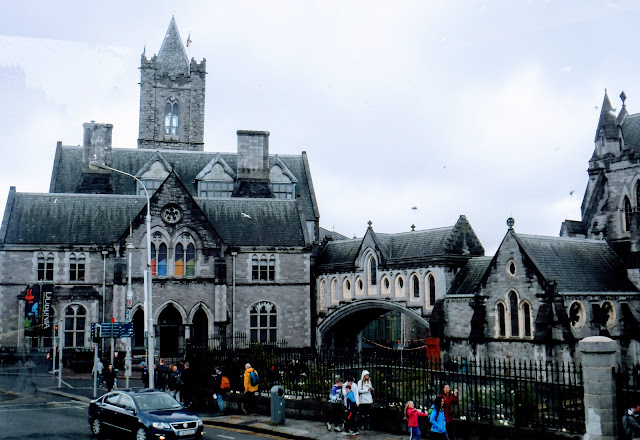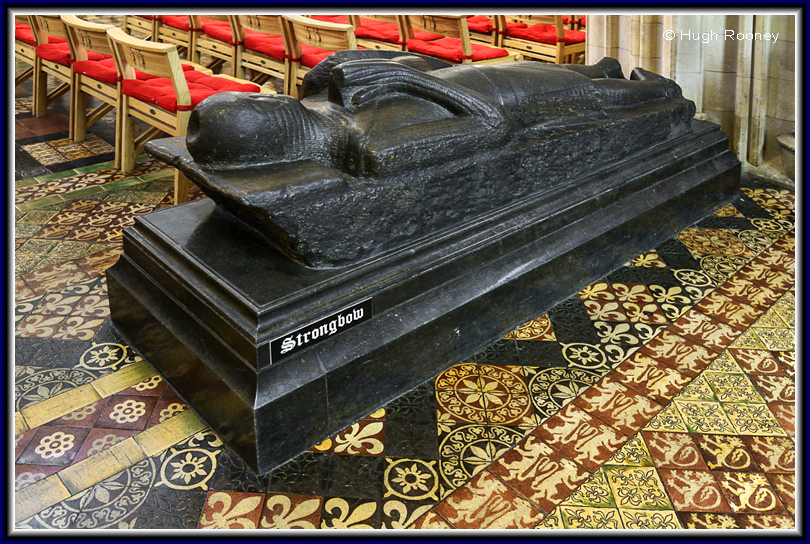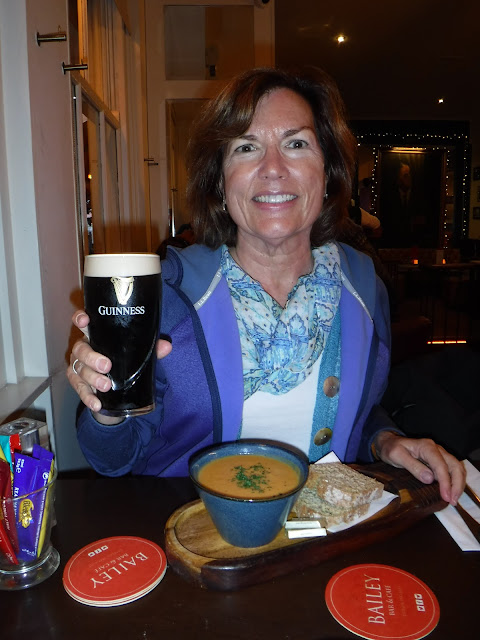Oh My Guinness! Days 2-4 Dublin, Ireland
Even though we were a tad jet-lagged during our entire 4 day stay in Dublin, we managed to have an amazing time. Our days were fun-filled with walking, visiting historical sites, museums, eating delicious food, talking with the locals, and drinking a pint, or two, of Guinness.
We started off our second day with a historical-cultural walking tour of Dublin, led by a young Trinity history professor who had a good sense of humor. With him, we walked through some of Dublin's arguably most interesting and unique historical sites. We became immersed in Ireland's past history and its impact on today's current events. Being led by a passionate historian and one with true local knowledge, we felt like we were beginning to know the real Dublin.

We started off our second day with a historical-cultural walking tour of Dublin, led by a young Trinity history professor who had a good sense of humor. With him, we walked through some of Dublin's arguably most interesting and unique historical sites. We became immersed in Ireland's past history and its impact on today's current events. Being led by a passionate historian and one with true local knowledge, we felt like we were beginning to know the real Dublin.

One of the many highlights of our walking tour included Christ Church, in the photo below. It is Dublin's oldest cathedral and is considered by many to be the spiritual heart of the city.
It was originally built in 1038 within the center of the walled city of Dublin as ordered by the Viking king, King Sitric Silkenbeard. This wooden church needed a major rebuilding and in 1170 Christ Church became a massive stone Romanesque structure. Throughout the centuries, the church fell into disrepair. Fast forward to the late 1800s when the Dublin whiskey distiller, Henry Roe, gave the equivalent of 35 million in today's dollars to save the cathedral. This allowed an extensive renovation of the interior and exterior. It is also the reason the exterior stonework and trim of Christ Church looks more Victorian than Anglo-Norman or Gothic.
During its renovation in 1875, an iconic addition was constructed connecting the cathedral to the old Synod Hall. It is Dublin's own "Bridge of Sighs" modeled after the one in Venice.
The Synod Hall, to the left of the "Bridge of Sighs" in the above photo, now holds the Viking multimedia exhibition, "Dublina". There one can see the vast, sturdy crypt of the first Norman king, Strongbow, 1130-1176.
In 1562 the roof of the nave collapsed and crashed onto Strongbow's tomb. Throughout the centuries, additions have been made to this area. Most recently, an extensive renovation from the late 1990s to early 2000, and today's tomb honors this Viking king in a more contemporary fashion.
Interestingly, Christ Church contains the largest Cathedral Crypt in all of Britain or Ireland!
We also enjoyed Dublin Castle.
The Dublin Castle which was built on the site of the first Viking fortress was the seat of British rule for nearly 700 years. It was a major British government complex up until 1922 when the British handed the government over to the Irish.
Up until that time, it was a symbol of English reign. Therefore, Dublin Castle was the main target of the 1916 "Easter Rising". Even though this Irish uprising was unsuccessful and ultimately resulted in the Irish rebels' beheadings by the British, it nonetheless, ultimately led to an outraged uprising and the end of British rule in Ireland in 1922.
As if right on cue, as soon as our lovely tour ended, the heavens opened up, and it poured buckets!
So we dashed into a pub, ordered a delicious lunch, a pint of Guinness, and watched the Dublin world splash by.
The rain let up and
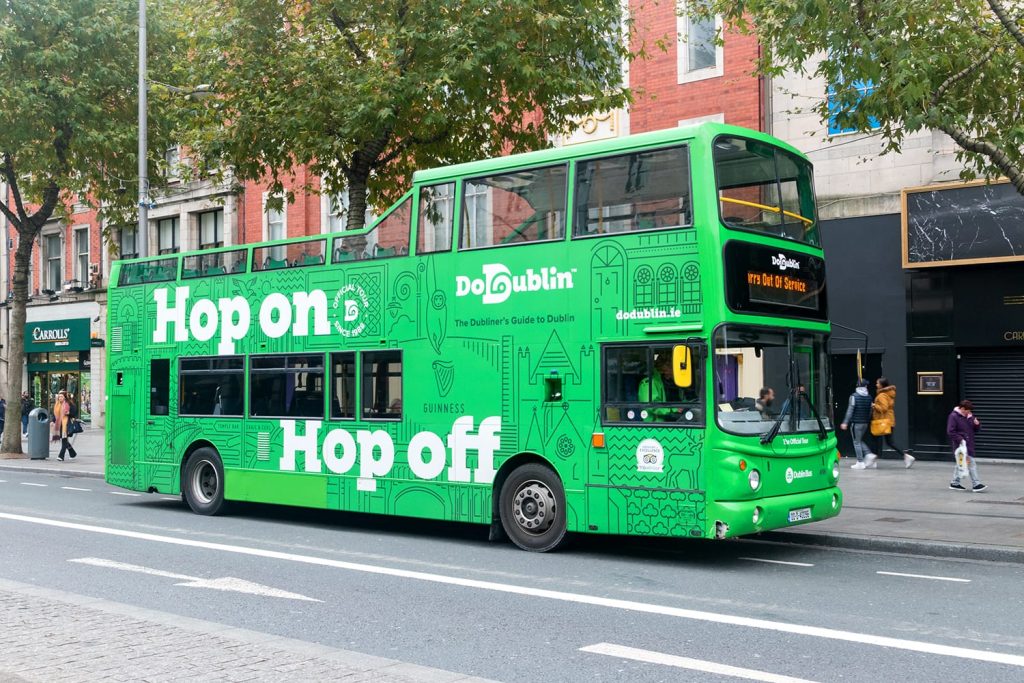
we jumped aboard the double-decker Green Hop-On-Hop-Off bus and purchased a 48-hour pass. The buses run every 20 minutes from different points of interest so you can hop on and off anywhere in the city. All of the Green Hop-On-Hop off buses have excellent drivers who are also professional guides and delightful storytellers. Each driver brings the city to life and each ride is unique.
When we got on our Green Hop-On-Hop-Off double-decker bus, little did we know when we found our seats in the covered upper-level area that we were in for the ride of our lives. Our 2-hour route was an ongoing comedy routine by our bus driver, Jason, who truly missed his calling by not being part of Saturday Night Live. He was hilarious! Everyone on the bus was laughing at his hysterical “historical” commentary that few got off at their stops. It was a great way to stay dry, see the sights from "on high" and learn amazing trivia about this capital city!
Another highlight of our stay in Dublin was the Guinness Storehouse.

All I can say is, "Oh My Guinness!" It is a gorgeous, modern interior with 5 floors of history. There's even a Guinness Academy where one can learn how to pour a perfect pint of Guinness. We learned how to be "perfect pourers" of a pint of Guinness,

and we have our diplomas to prove we're now professional pint pourers!

We had tons of fun, met a lot of very friendly folks, and had a lovely time!

The afternoon we went to the Guinness Storehouse, we knew we had to catch the last Green Hop-On-Hop-Off bus of the day or else we'd have to call an expensive taxi to drive us back to our hotel. We barely made it to the bus stop in time (we had been having a tad too much fun in the Guinness Storehouse) and as we jumped on board, we couldn't believe it but our bus driver was Jason! What are the odds?! He remembered us from the day before and we couldn't have asked for a better way to spend a long early evening drive home through the streets of Dublin than with Jason singing Irish songs, and regaling us with his running banter of jokes and Irish sayings.
Here are a few tidbits we gleaned from our visit to the Guinness Storehouse:

All I can say is, "Oh My Guinness!" It is a gorgeous, modern interior with 5 floors of history. There's even a Guinness Academy where one can learn how to pour a perfect pint of Guinness. We learned how to be "perfect pourers" of a pint of Guinness,

and we have our diplomas to prove we're now professional pint pourers!

We had tons of fun, met a lot of very friendly folks, and had a lovely time!

The afternoon we went to the Guinness Storehouse, we knew we had to catch the last Green Hop-On-Hop-Off bus of the day or else we'd have to call an expensive taxi to drive us back to our hotel. We barely made it to the bus stop in time (we had been having a tad too much fun in the Guinness Storehouse) and as we jumped on board, we couldn't believe it but our bus driver was Jason! What are the odds?! He remembered us from the day before and we couldn't have asked for a better way to spend a long early evening drive home through the streets of Dublin than with Jason singing Irish songs, and regaling us with his running banter of jokes and Irish sayings.
Here are a few tidbits we gleaned from our visit to the Guinness Storehouse:
1. Guinness is the national beer of Ireland
2. They are currently brewing a million pints a day (!) and they ship all around the world
3. The trademark Guinness harp is represented as a reverse harp out of respect for Ireland's national "true harp" insignia.
4. Arthur Guinness' wife, Olivia, gave birth to, yes this is actually true, 21 children! And as Jason was want to say, "Aye, so it proves it, ladies and gentlemen. A pint of Guinness will give ya great strength and it also won't give ya a headache."
5. Authur Guinness signed a 9,000-year lease for St. James Gate Brewery in 1759.
6. The Guinness Storehouse welcomed 1.7 million visitors last year. Since its opening in November of 2000, it is well on its way to its 20 millionth customer this year!
Cheers!
6. The Guinness Storehouse welcomed 1.7 million visitors last year. Since its opening in November of 2000, it is well on its way to its 20 millionth customer this year!
Cheers!
Since we had now experienced the #1 international tourist attraction in all of Ireland, which perhaps is not surprising considering that the oldest pub in Dublin dates back to 1198, we spent the following two days visiting the more cerebral sites of Dublin, namely the national treasures of the Book of Kells and the Old Library Long Room, located in the 18th-century Old Library building in the heart of Trinity College.
The Book of Kells is one of the greatest treasures of medieval Europe, dating from the 9th century, over 800 years old, and contains the four gospels of the New Testament (Matthew Mark, Luke, and John). It is written in Latin and was created by early Christian monks. It is a masterwork of Western calligraphy, employing decoration that is extremely rich and colorful but is also, in places, deeply enigmatic. It is regarded as Ireland's finest national treasure. It was astounding.
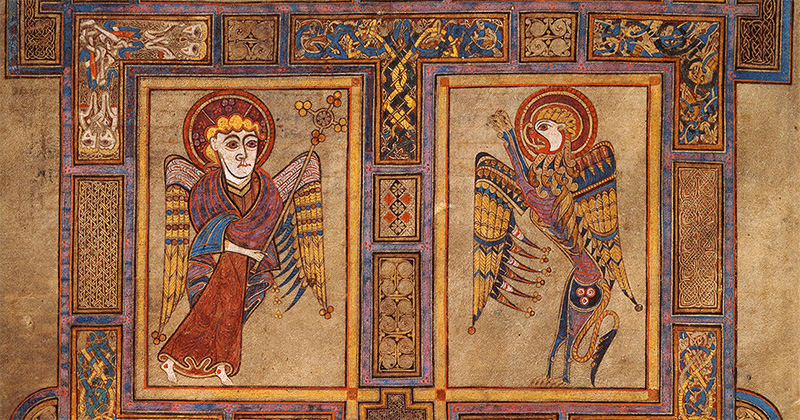


Over 680 pages are made from vellum (calfskin prepared for writing). The monks used over 150 calfskins to create these elaborately and delicately decorated, intricately illustrated pages in the Book of Kells.


Adjacent to the Book of Kells is an extraordinary room and it has to be seen to be believed! It is the Long Room of the old Trinity Library.



Built between 1712 and 1732, the main chamber of the Old Library is the Long Room. It is nearly 215 feet in length 72 feet high. It is filled to the rafters with well over 200,000 books. It is arguably one of the most impressive libraries in the world.


Another icon of Irish history is the 14th century "Brian Boru" harp, the oldest surviving Gaelic harp. It is the national symbol of Ireland.

This beautiful Brian Boru harp is made of oak and willow and is exquisitely carved. It has 29 brass strings but originally had 30. Considering it was created in the 1300s, this beautiful national symbol of Ireland is well preserved and extremely well-loved by the Irish.
The Old Library is considered to be architect Thomas Burgh’s greatest building. The foundation stone was laid in 1712 and took 20 years to complete. Sadly, Thomas Burgh died 2 years before it was finished.

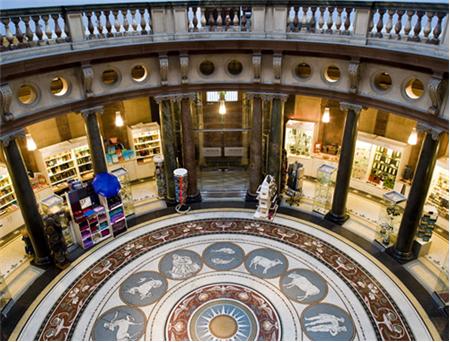
From its Viking origin to actual Irish independence thus becoming the "city that fought an empire", Dublin has an amazing, hard-fought history! Whew! There was a lot to take in but over the course of the past four days, we sure enjoyed learning about it. We most especially enjoyed meeting Dublin's friendly folks as we wound our way through this city's amazing history.
We loved our stay in Dublin, but it was time to journey on. Tomorrow we leave Dublin, rent a car at the airport and drive on the wrong side of the road to Kilkenny where we will continue our adventure to explore and hike Ireland!
The Book of Kells is one of the greatest treasures of medieval Europe, dating from the 9th century, over 800 years old, and contains the four gospels of the New Testament (Matthew Mark, Luke, and John). It is written in Latin and was created by early Christian monks. It is a masterwork of Western calligraphy, employing decoration that is extremely rich and colorful but is also, in places, deeply enigmatic. It is regarded as Ireland's finest national treasure. It was astounding.



Over 680 pages are made from vellum (calfskin prepared for writing). The monks used over 150 calfskins to create these elaborately and delicately decorated, intricately illustrated pages in the Book of Kells.


Adjacent to the Book of Kells is an extraordinary room and it has to be seen to be believed! It is the Long Room of the old Trinity Library.
Spiral staircases lead to the upper level.


There are also ladders to help retrieve those hard-to-reach books.

Built between 1712 and 1732, the main chamber of the Old Library is the Long Room. It is nearly 215 feet in length 72 feet high. It is filled to the rafters with well over 200,000 books. It is arguably one of the most impressive libraries in the world.

The distinctive and beautiful barrel-vaulted ceiling was added in 1860 to allow space for more works when the existing shelves became full. Lining the central walkway of the 215-foot long room are marble busts of famous philosophers and writers as well as distinguished men connected to Trinity College.

In addition to the 200,000 books, the Long Room also houses a rare copy of the 1916 Proclamation of the Irish Republic, one of only three in existence today.


Another icon of Irish history is the 14th century "Brian Boru" harp, the oldest surviving Gaelic harp. It is the national symbol of Ireland.

This beautiful Brian Boru harp is made of oak and willow and is exquisitely carved. It has 29 brass strings but originally had 30. Considering it was created in the 1300s, this beautiful national symbol of Ireland is well preserved and extremely well-loved by the Irish.

The Old Library is considered to be architect Thomas Burgh’s greatest building. The foundation stone was laid in 1712 and took 20 years to complete. Sadly, Thomas Burgh died 2 years before it was finished.
Famous readers of the Long Room have left letters that can be viewed. They include Oscar Wilde (author, poet, and playwright), Samuel Beckett (novelist, playwright, and theater director), and Bram Stoker (novelist and creator of Dracula).
The rich wood paneling, wrought iron staircases, and giant frosted windows providing a glorious filtered light giving the books a golden glow, all add to the ambiance of what is indeed a very special place.
We were so taken with the library in The Long Room that we returned the following day to just sit, absorb and honor the amazing accomplishments of all those authors who are no longer with us, and yet whose written words live on today in these 200,000 books.
When we ventured back outside, it was still raining. So we headed over to
the Museum of History and Archeology.
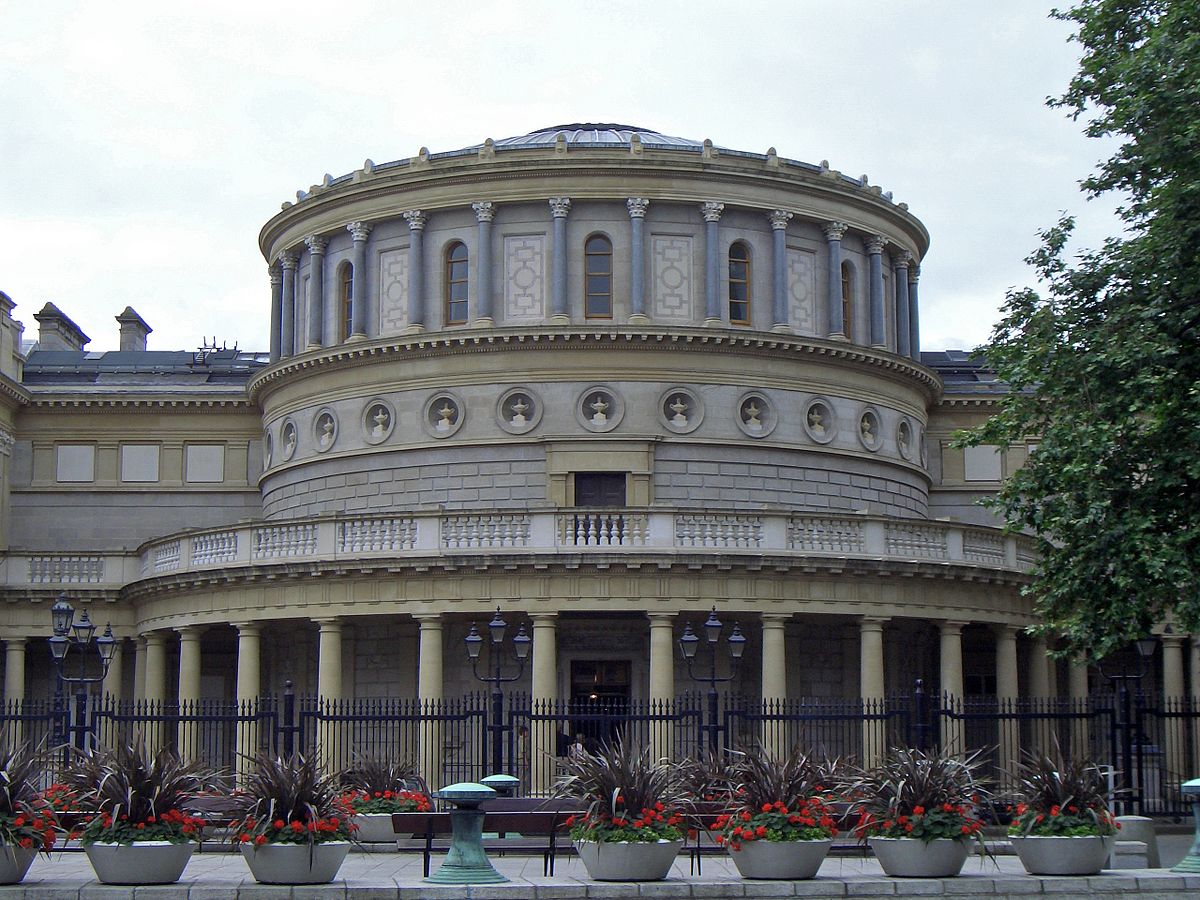
The Museum of History and Archeology is a beautiful historical building with some amazing floor mosaics.
When we ventured back outside, it was still raining. So we headed over to

The Museum of History and Archeology is a beautiful historical building with some amazing floor mosaics.


The permanent collection of Ireland's historic gold jewelry was stunning.
It brought new meaning to the old Irish saying, "May the rocks in your field turn to gold." The exhibition, from prehistoric goldwork ranging in date between 2200BC and 500 BC, is one of the largest and most important in western Europe.
This beauty below is from the 1st century BC and was found in Derry, Ireland.
The special exhibition about the Vikings in Ireland was exceptional! Their life-size replica of the 1014 Viking ship was exquisite.
In addition, there were hands-on exhibits along with exhibits of amazing artifacts that had been preserved in bogs for centuries and many have just recently been discovered in Irish farmers' fields. I had no idea how ingenious nor how advanced the Vikings were. Also, there were interactive hologram exhibits depicting the life and times of historic Vikings. It was very impressive and extremely informative.
We loved our stay in Dublin, but it was time to journey on. Tomorrow we leave Dublin, rent a car at the airport and drive on the wrong side of the road to Kilkenny where we will continue our adventure to explore and hike Ireland!


